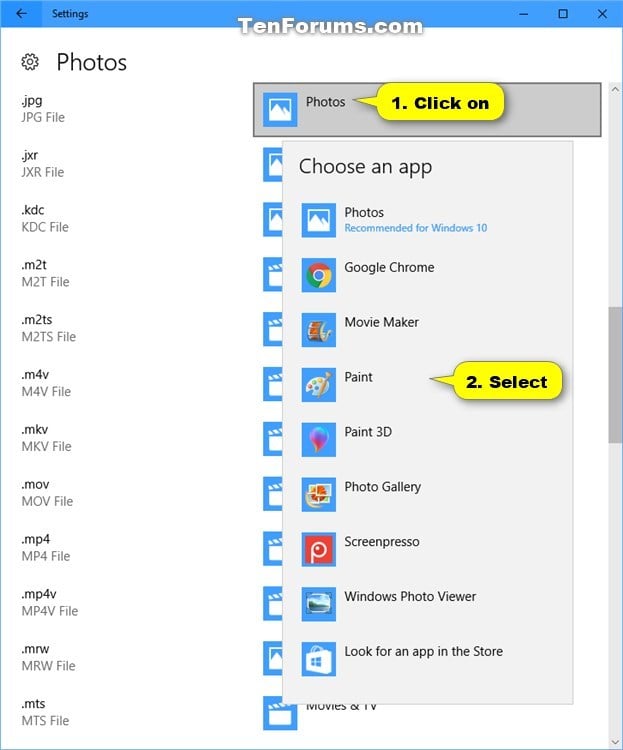
- #Set defaults windows 10 how to#
- #Set defaults windows 10 update#
- #Set defaults windows 10 windows 10#
- #Set defaults windows 10 password#
#Set defaults windows 10 how to#
Learn how to set up Mozilla Firefox and Google Chrome on macOS. The following instructions work only for Internet Explorer, Microsoft Edge, and Google Chrome on Windows (if Google Chrome shares a set of trusted site URLs with Internet Explorer). It isn't required for direct user sign-ins. This prerequisite is applicable only when you enable the Seamless SSO feature. If URL-based proxy exceptions aren't possible in your organization, you can instead allow access to the Azure datacenter IP ranges, which are updated weekly. If you require a specific URL instead of a wildcard for proxy configuration, you can configure, where tenantid is the GUID of the tenant for which you're configuring the feature. If your firewall or proxy allows, add the connections to your allowlist for *. URLs over port 443. You use Azure AD Connect version 1.1.644.0 or later.
#Set defaults windows 10 password#
If you use password hash synchronization as your sign-in method and there's a firewall between Azure AD Connect and Azure AD, ensure that: Set up your Azure AD Connect server: If you use pass-through authentication as your sign-in method, no other prerequisite check is required. To deploy Seamless SSO for Azure AD by using Azure AD Connect, complete the steps that are described in the following sections.Įnsure that the following prerequisites are in place: Seamless SSO provides your users with easy access to your cloud-based applications without using any other on-premises components. Azure Active Directory (Azure AD) Seamless single sign-on (Seamless SSO) automatically signs in users when they're using their corporate desktops that are connected to your corporate network.

Give it a name then in the "Custom OMA-URI" Settings, use the following OMA-URI. Select "Windows 10 and later" as platform and "Custom" as profile Type. Now, navigate to InTune and create a Device Configuration profile. The output in the lower box will be the value to use in Intune. Copy your XML in the top windows, select UTF-8 as format and CRLF as destination newline separator (since we'll deploy it on Windows devices). There are a lot of sites and freewares that can achieve this conversion, a very good one is. When ready, the XML file need to be converted to Base64 format. The below file will thus set Edge as default browser, Outlook as default mail handler and VLC as default media player. You should also make sure that the computers you deploy the policy actually do have the apps installed (this can also be achieved via InTune). Since you probably only want to define some associations only, just remove the line you don't need to deploy. If you upload it as is, then ALL computers in your company will have the same apps associations than contained in the XML.

The generated file will look like this, and will most probably be much longer than the below sample. DISM /Online /Export-DefaultAppAssociations:DefaultAssociations.xml The name of the file itself doesn't matter. Open a command prompt to export the XML file with all apps associations and run the following command to create an XML file named "DefaultAssociations.xml" in the current folder.
#Set defaults windows 10 windows 10#
On a Windows 10 device, configure the required apps associationsĮxport the said configuration to an XML fileĮventually modify or shorten the XML fileįrom a Windows 10 device, configure the default apps associations (Settings > Default Apps) The complete reference / documentation is available on Microsoft Docs website.
#Set defaults windows 10 update#
but InTune also has a feature to check the minimal Windows version, and another one to update your clients. This policy is applied at sign-in.īefore deploying your template to Intune, pay caution to the exact Windows 10 version that is installed on client devices. Here is a quick overview regarding how you can set default apps associations in Windows 10. Of course it's a little bit more complex than using the template, but it gives much more functionalities. The Policy Configuration Service Provider enables companies to configure specific policies on Windows 10 beyond the default templates provided by the Device Management Portal.


 0 kommentar(er)
0 kommentar(er)
